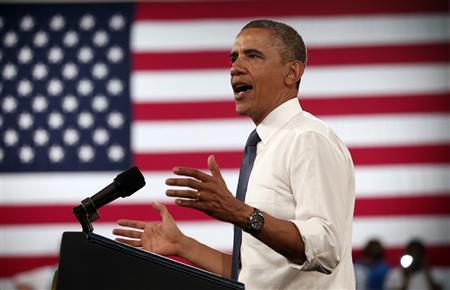(Reuters) – President Barack Obama insisted on Friday his healthcare overhaul is already proving worthwhile as he promoted the plan in California, where an argument is raging over whether it is living up to its name as the Affordable Care Act.

“If you’re one of 6 million Californians or tens of millions Americans who don’t currently have health insurance, you’ll soon be able to buy quality, affordable care just like everybody else,” he said in San Jose, California.
A part of the 2010 law that requires insurers to spend 80 percent of premiums on healthcare or reimburse money to consumers has prompted insurance companies to give rebates to consumers of $45 million this year in California, he added.
“All of this is happening because of the Affordable Care Act,” Obama said.
Support for the reform in California, the nation’s most populous state, is seen as crucial to the success of Obama’s signature domestic policy when millions of uninsured Americans are able to choose health plans beginning on October 1.
At issue are prices for the new plans proposed by insurance companies and made public late last month. Supporters of “Obamacare” said the prices were lower than expected and hailed them as an early sign of success, but opponents quickly took issue and said they would make insurance more expensive than what is currently on the market.
Obama said once California and other states who agreed to participate have fully functional insurance marketplaces, this system will offer consumers a choice of healthcare plans that should drive costs down.
People with incomes well below the poverty level will do well since they will be eligible for government subsidies of their coverage, said Joseph Antos, a health policy economist with conservative think tank American Enterprise Institute.
“It’s going to be the ones further up who end up paying,” he said. “It’s also the taxpayer who is going to end up picking up the cost of the subsidies that are going to be offered nationwide.”
It may take months before Americans can fully gauge the value of the plans they will be offered in October. The premium rates figuring into the California argument are only preliminary, while other details, such as the number of doctors in each plan, are unknown.
With 6 million uninsured residents, California has been one of the quickest states to develop its own health insurance exchange. Healthcare advocates hope that as many as 1 million uninsured Californians will sign up for the new plans in the first year and lead other states to do the same.
“It’s a large market and a positive media market for the president,” said Dan Mendelson, chief executive officer of research firm Avalere Health. “He’s going to get coverage when he goes to California. And what they need to do right now is amp up the visibility around implementation.”
The federal government aims to enroll about 7 million Americans in health insurance plans through the exchanges, a senior administration official said in a briefing before the speech.
Covered California, the California state exchange, said on May 23 that it had given initial approval to 13 different companies to sell plans, from big names like WellPoint Inc’s Anthem Blue Cross of California to smaller players such as Health Net Inc and Molina Healthcare Inc.
Rates would be from 2 percent above to 29 percent below the 2013 average premium for small employer plans, according to state exchange officials. The cost to a 40-year-old would be between $40 to $300 per month for a midlevel plan, depending on the person’s income level and subsidies.
“Obviously, there is more work to do on affordability,” said Anthony Wright, executive director of consumer advocacy coalition Health Access California. “Even in the best of circumstances, health insurance isn’t cheap.”
RATE SHOCK
Billed as a success by the state and federal governments and health economists when it was announced on May 23, the rates have since come under fire. Healthcare policy expert and Forbes commentator Avik Roy said that prices were in fact going up as much as 146 percent for some people compared with those for individual plans for sale now in California.
Insurance executives and Republicans also espoused this “rate shock” argument, which had quieted down earlier last month after low proposed premiums were released by a few other states, including Washington, Oregon and Vermont.
Enrollment is essential for the success of the insurance exchanges as the government seeks to get millions of Americans to sign up and provide a diverse enough risk pool to make the insurance competitive. The government will pay subsidies to people who earn less than 400 percent of the federal poverty level.
At least 2.6 million people on the exchanges need to be young and healthy for the exchanges to succeed, the senior administration official said.
In California, about 2.6 million people will have incomes low enough to qualify for government subsidies and nearly half of those individuals are Latino, the official said. Efforts are now under way in the state through on-the-ground partnerships to inform people about the exchanges.
“It’s premature right now for people to be figuring out whether they can afford this,” said Linda Blumberg, health economist at the Urban Institute.
Marketing for the new insurance plans in California and other states running their own exchanges is due to take off in July. Blumberg hopes that will be when information about the benefits of these insurance products becomes clearer: that they provide essential benefits like maternity coverage, that they cannot deny customers based on preexisting conditions, and that there is financial assistance.
Those and other changes under the health law, such as men and women paying the same price on the exchange, are some of the reasons why it is difficult to compare California’s announced prices for 2014 with currently available individual plans.
In addition, there are up to four tiers of health exchange products under Obama’s health law, starting with a minimum amount of coverage set by the government and climbing higher.
“The policies are different – generally more comprehensive,” said Gerald Kominski, director of the UCLA Center for Health Policy Research. “They offer better coverage, less out-of-pocket costs.”
(Additional reporting by Caroline Humer and Deena Beasley; Editing by Michele Gershberg, Doina Chiacu)





